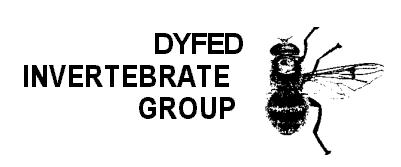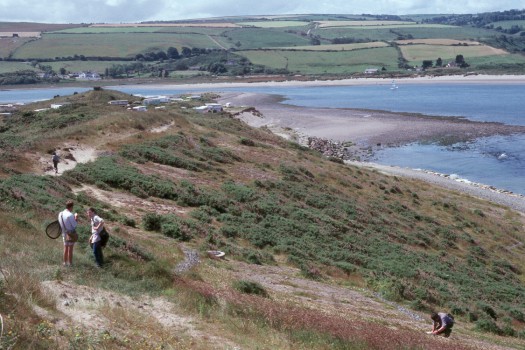

Dyfed Invertebrate Group
The Dyfed Invertebrate Group was formed in the autumn of 1985 when, by chance, Adrian Fowles and Ian Morgan shared a house at Caemawr, Eglwysfach, for six months. Amateur enthusiasm and a sense of vice-county competitiveness spurred us on and led to the exploration of more and more groups of invertebrates as and when we managed to obtain identification keys. The significance of our observations, however, was difficult to realise as there was hardly any regional literature available on the distribution and status of most of the obscure groups we dabbled in. One of our many discussions concluded with a resolve to improve the situation and hence the Dyfed Invertebrate Group came about, continuing for sixteen years until 2001. We enlisted the support of Steve Coker and together we set about with the worthy aim of improving understanding of the non-marine invertebrates in the three vice-counties of Cardiganshire, Carmarthenshire and Pembrokeshire that form the south-western corner of Wales. Historically this part of Wales had received little attention from invertebrate specialists and as such there was plenty of scope for exciting discoveries and to influence conservation management of important sites. Inevitably the Group relied on the commitment and enthusiasm of a few members, but the achievements also relied on the contributions of many local naturalists who attended field meetings and supplied records. Three field meetings were held each summer from 1986 to 1991, with two final meetings in 1993, but in addition the Group made two site assessments (Cardigan Island and Carew Castle) to assist with the management of specific sites. In total twenty-two sites were surveyed by the joint endeavours of Group members. Another important output was the publication of reviews of important sites across the region and nine sites were featured in the 'Dyfed Site Reports' that appeared in the early years of the Newsletter.
The Newsletter focussed on review papers and specialists were encouraged to provide summaries of the existing knowledge on particular groups, either for Dyfed as a whole or for the individual vice-counties. Over forty papers of this nature were published, covering:
Dyfed: aquatic Coleoptera, Coleoptera Carabidae, Coleoptera Cantharidae, Coleoptera Coccinellidae, saproxylic Coleoptera, Diptera Conopidae, Orthoptera, Mecoptera & Neuroptera, Trichoptera, Chilopoda, Araneae, Opiliones, Siphonaptera.
Cardiganshire: Coleoptera Nitidulidae, saproxylic Coleoptera, Diptera Sciomyzidae, Hemiptera Heteroptera, Hymenoptera Formicidae, Lepidoptera, Thysanura, Araneae, Isopoda, Mollusca, Pseudoscorpiones.
Carmarthenshire: Coleoptera Carabidae, Coleoptera Cerambycidae, Diptera Brachycera, Diptera Syrphidae, Hemiptera Heteroptera, Hymenoptera Aculeata, Hymenoptera Formicidae, Lepidoptera, Neuroptera, Diplopoda, Isopoda, cave Crustacea, Mollusca.
Pembrokeshire: peatland Coleoptera, Hemiptera Heteroptera.
Another prominent feature of the Newsletter was the annual summary, in which the county recorders reported on additions to the county checklists or highlighted particularly interesting records. It is a testament to the success of the Dyfed Invertebrate Group that the first annual round-up in 1986 consisted of 19 pages, but by 1991 this had grown by almost 50% to 28 pages. Thereafter, following the departure of some key members, the Dyfed Invertebrate Group became less active but the summaries continued up until the last issue, ensuring a permanent record of the fortunes of Dyfed's invertebrates over a fifteen year period.
During the sixteen years of its existence the Group produced 37 issues of its Newsletter, consisting of 802 pages and containing 334 articles by 54 different authors. Initially the Newsletter appeared four times per annum but after 1991 publication was less frequent. Circulation was small, less than 100 copies per issue, but the series has been lodged in several reference libraries (including the British Library and the National Library of Wales), thus ensuring permanent access to hard copy for future generations of naturalists. The Newsletter was abstracted for the Zoological Record, but the full text of the articles deserve wider accessibility and hence this website has been created to enable distribution of the Newsletters as pdf files via the internet.
Each issue has been scanned with OCR software so there are occasionally differences between the layout of the electronic text and the hard copies, especially with regard to tables. Each page has been checked after scanning but errors are possible and the definitive version of each article remains the printed text (later issues are more prone to incorrect character attribution and hence are more likely to contain typographical errors, including grid references). Please draw attention to any errors by e-mailing [email protected].
Contents Field Meetings County Reviews

DIG
Field meeting: Gwbert 12 July 1987